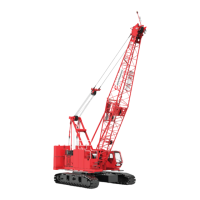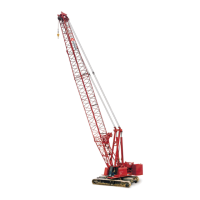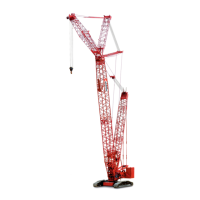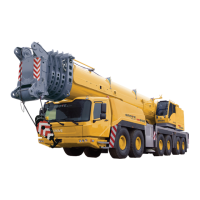Manitowoc Published 11-22-17, Control # 257-02 6-1
MLC300 SERVICE/MAINTENANCE MANUAL SWING SYSTEM
SECTION 6
SWING SYSTEM
GENERAL
This section provides the hydraulic and electrical information
for the crane’s swing system. Hydraulic and electrical circuit
schematics are provided (see Figure 6-1
, Figure 6-2, and
Figure 6-3
).
Details of individual components are covered later in this
section. Component information can also be found in the
following sections of the Service Manual:
• Section 2: Hydraulics
• Section 3: Electrical
SWING SYSTEM OVERVIEW
The swing system is a closed-looped system consisting of a
hydraulic pump and a fixed displacement motor.
The swing pump is an engine-driven, electronically
controlled, bi-directional, variable-displacement pump with
electronic displacement control (EDC) that provides
hydraulic flow to the swing motor.
The swing motor is a bi-directional, fixed displacement motor
mounted on the planetary swing drive. To swing the crane,
the swing motor rotates a pinion gear. The pinion gear
meshes with a ring gear that is attached to the carbody,
causing the rotating bed to rotate relative to the carbody.
The speed of the swing motor is proportional to the output
flow volume of the swing pump that is controlled by the
position of joystick J1.
The joystick J1 left-right position determines the crane’s
swing direction and speed. Joystick J1 also has a
momentary contact holding brake switch to control the swing
brake.
Joystick J1 communicates with the crane’s control system
using the controller area network bus (CAN Bus).
NOTE: Joystick J1 has no external locations where
voltages can be checked.
Swing speed and swing torque can be selected for the type
of work being performed in the Speed and Torque Settings
Screen of the main display (see the MLC300 Main Display
Operation Manual).
SWING BRAKE OPERATION
A spring-applied, hydraulically-released disc brake is located
between the swing motor and its planetary drive. The swing
brake must be actively released by the control system. If
brake hydraulic pressure or electrical control is lost, the
swing brake is applied by spring force.
The swing brake release system uses charge pressure from
pump 2 that is supplied to the swing brake release solenoid
valve. The hydraulic pressure must be above 18 bar
(261 psi) to fully release the brake. If the pressure is less
than 18 bar (261 psi), the brake could remain partially
applied, which could damage the swing brake system.
Park Switch Control
Joystick J2 sends 24 V
DC
to the swing park switch. When the
swing park switch is in the UN-PARK position, the switch is
closed, sending 24 V
DC
back to joystick J2.
Joystick J2 communicates the un-park command to the
CCM-10 control module via CAN Bus A. The CCM-10 control
module relays the command to CCMC11 control module via
CAN Bus C. The CCMC11 control module then sends
24 V
DC
to the swing brake release solenoid valve, energizing
the solenoid. The solenoid valve shifts position, routing
hydraulic fluid to the swing brake, releasing the brake.
When the swing park switch is in the ON-PARK position, the
swing brake switch is open, sending 0 V
DC
to joystick J2.
Joystick J2 communicates the on-park command to the
CCM-10 control module via CAN Bus A. The CCM-10 control
module relays the command to CCMC11 control module via
CAN Bus C. The CCMC11 control module then sends 0 V
DC
to the swing brake release solenoid valve, de-energizing the
solenoid. This causes the solenoid valve to return to the
default position, allowing the hydraulic fluid in the brake to
flow back to the tank. The reduced hydraulic pressure allows
spring force to apply the brake.
Holding Brake Switch Control
When the holding brake button on joystick J1 is pressed,
joystick J1 sends a brake command to CCMC11 control
module via the CAN Bus. The CCMC11 control module then
sends 0 V
DC
to the swing brake release solenoid valve, de-
energizing the solenoid. This causes the solenoid valve to
return to the default position, allowing the hydraulic fluid in
the brake to flow back to the tank. The reduced hydraulic
pressure allows spring force to apply the brake.

